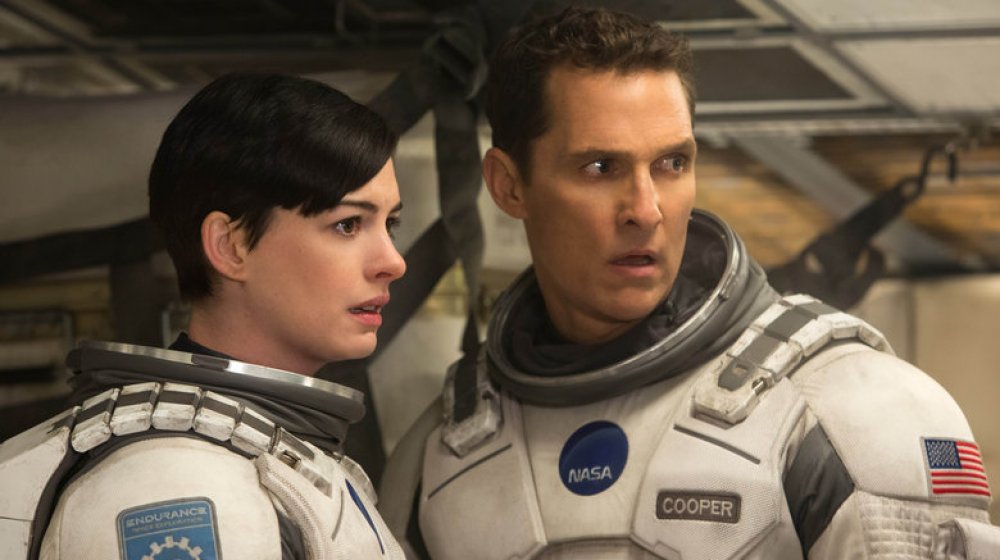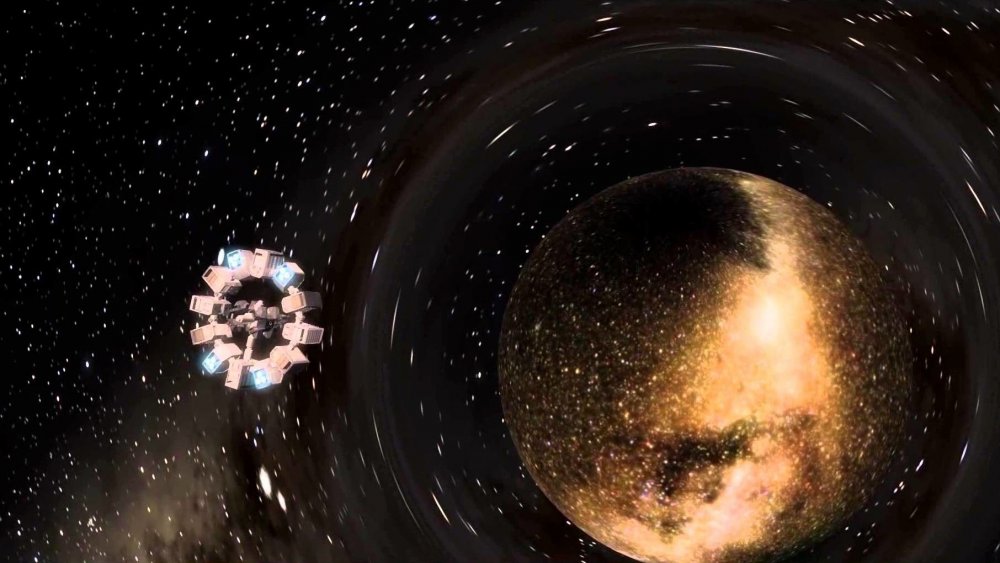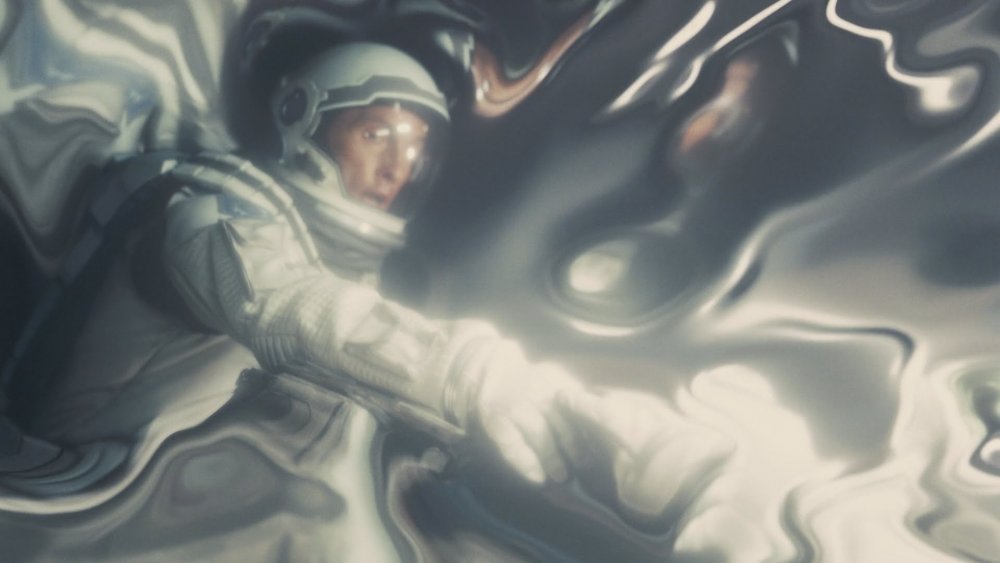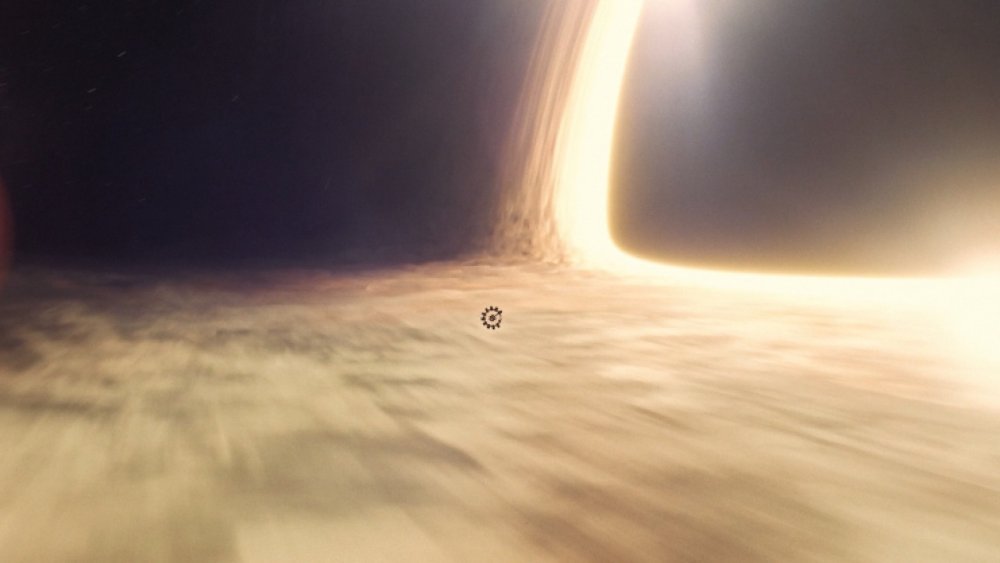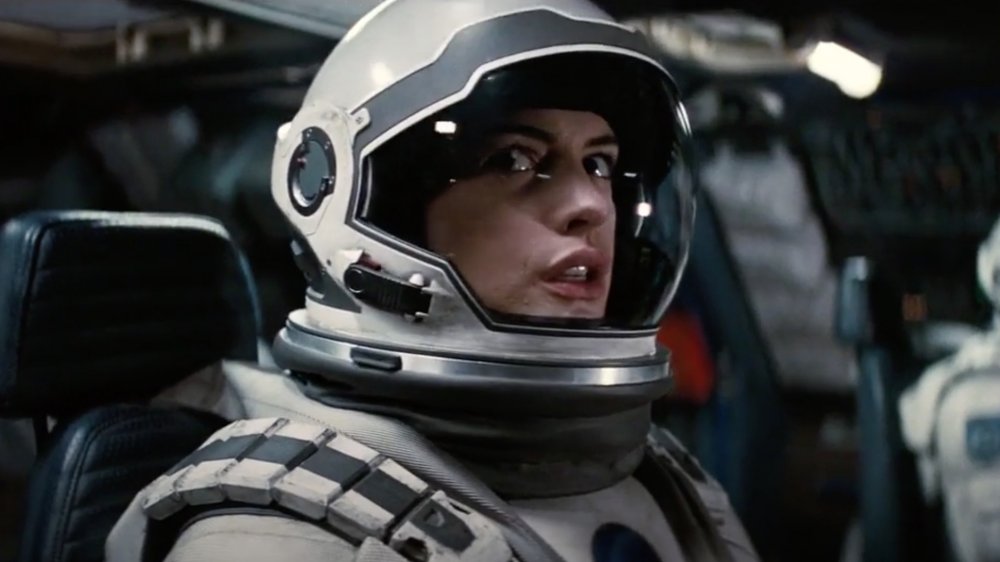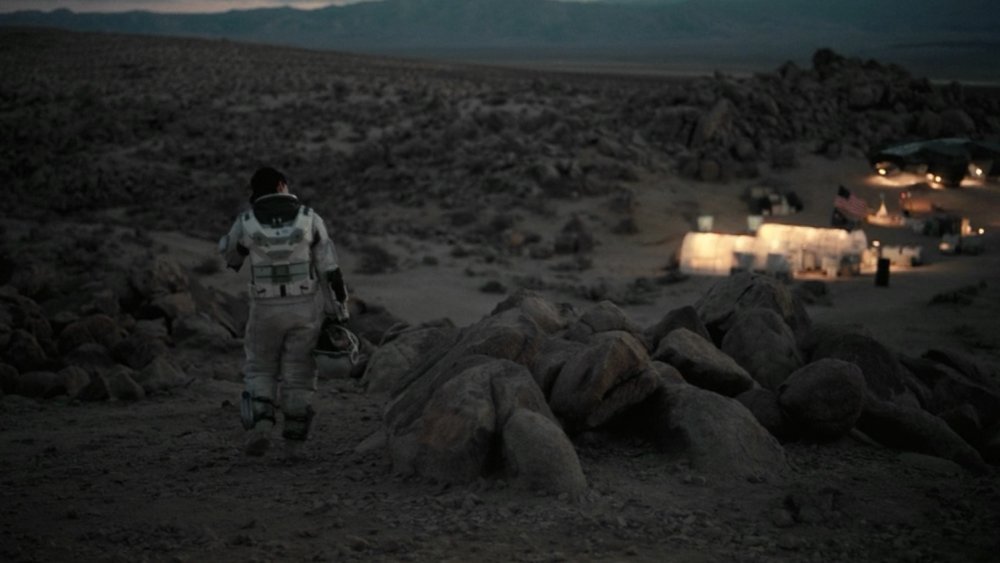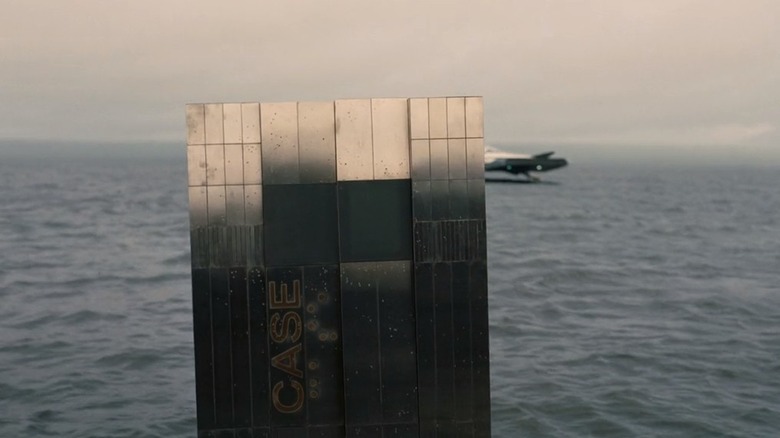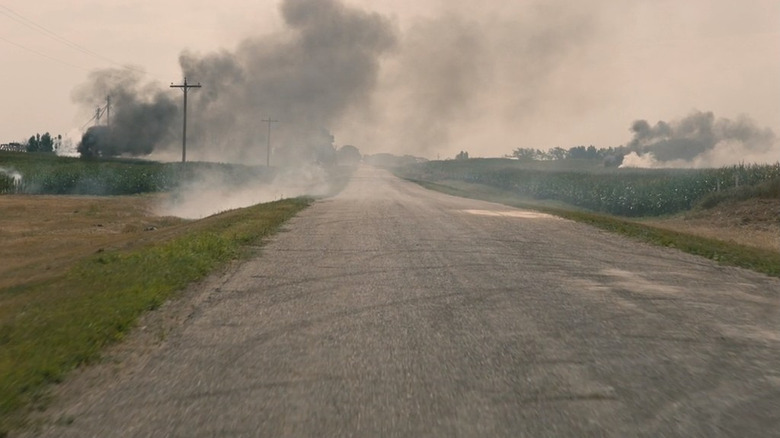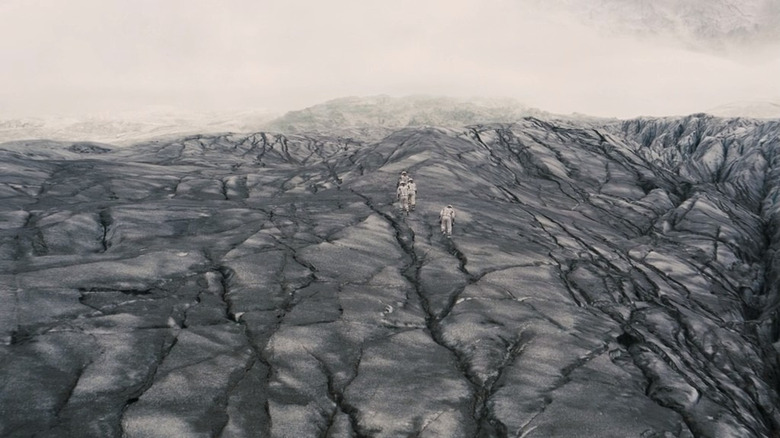Times Interstellar Got Science All Wrong
Throughout his lauded two-decade-plus career behind the camera, Christopher Nolan has made a habit of taking viewers on unexpected journeys through fractured minds, wounded souls, and perilous moments in history. He's done so with such singular style, razor-sharp intellect, and sprawling spectacle that many have hailed him as big budget auteur on the level of Steven Spielberg. In 2014, Nolan set out to take movie lovers on his most ambitious cinematic journey yet, traversing space and time itself with the mind-bending sci-fi spectacular "Interstellar."
Set in a not-so-distant future, the near-flawless "Interstellar" finds Earth ravaged and on the verge of collapse under the weight of drought, famine, and superstorms. Sensing the end is truly nigh, mankind has turned its gaze again to the stars, hoping to find a new planet to call home. A crack team of astronauts and scientists (led by Matthew McConaughey and Anne Hathaway) embark into the far reaches of the universe in search of a planet capable of sustaining human life.
The journey of making "Interstellar" often found Nolan and his brother-slash-co-writer Jonathan pushing the boundaries of established and theoretical sciences alike to deliver a hard sci-fi tale as scientifically accurate as it is inherently open to the great unknowns of the universe. In doing so, they crafted a film that was generally applauded in the scientific community for its factual depictions of some truly complex scientific topics.
Of course, not all of the film's scientific basis is founded in reality because, well, the Nolans just couldn't let hard science fact get in the way of telling a great science fiction story. Not long after the film's 2014 release, a number of outlets including the Daily Mail reached out to a few specialists in the scientific fields covered in Interstellar to find out just how authentic the film's science really is. Here's what they found.
Sorry, but Interstellar's wormhole is still just theoretical
One of the central conceits of "Interstellar" is that the brave team of explorers can only venture to the far reaches of the universe via a wormhole in the general vicinity of Saturn. For those who don't know how wormholes work, they essentially "bend" space (imagine folding a piece of paper in half and not connecting the loose ends) to create a sort of shortcut between two locations in space. It's widely theorized that, under the right conditions, these shortcuts could be used as a sort of subway system through the galaxy. As exciting as that prospect is, the truth is nobody has ever actually found an existing wormhole, and as of this writing, they are purely theoretical.
Professor Martin Barstow of the Royal Astronomical Society was quick to point this fact out in his critique of the film's scientific accuracy, though he's also quick to acknowledge it's a solid storytelling device. "I don't think they really exist. Explaining how one might work is really in the realm of science fiction," Barstow told the Daily Mail. "There's no direct evidence such things exist in the universe. We know about black holes, but the idea of something connecting different parts of space is very much an idea in its infancy. But, from a dramatic point of view you've got to have something like this in the film like that otherwise it doesn't work."
Lauded scientific author Lee Billings is a bit harsher in her criticism of wormhole theory, labeling the theoretical portals with the dreaded scientific term miracles. "Saying that we have to rely on borderline miracles of physics makes it easier, but also makes it way harder," Billings said. "We have no idea if stable wormholes exist on a macroscopic scale." Real or not, the wormhole in "Interstellar" remains one of the film's most visceral and visually arresting creations.
Cooper's black hole trip is apparently pure science fiction
It seems that another enthralling scene from "Interstellar" is not entirely accurate. The moment comes in the third act of Nolan's film, and finds Cooper (McConaughey) leaving the team's Endurance spacecraft in hopes of lightening the ship's load, thus enabling Brand (Hathaway) to orbit a supermassive black hole, using its gravitational pull to visit several orbiting planets. Once inside "Gargantua," McConaughey ejects from his craft, beginning a fully psychedelic journey on par with "2001: A Space Odyssey." At journey's end, Cooper is still very much alive, and even lands near a shiny, planet-sized space station.
While the moment makes for grand storytelling and adds some truly astounding visual elements, per Professor Martin Barstow, there's absolutely no chance Cooper could have survived inside a black hole, let alone communicated with the outside world. "The gravitational field is extremely intense and changes very quickly," Barstow told the Daily Mail. "The idea is that anything that falls into it becomes like spaghetti, stretched out by gravity. So there's no chance that anything or anybody could survive in a black hole. Communicating out of one is also impossible."
Lee Billings takes matters further, explaining that radiation from a black hole would likely kill you before you ever actually got inside. "I think if astronauts ended up getting as close to the accretion disc around a supermassive black hole, as they did in the film, in reality they would have a bad time. Those things are going to be pouring off hard radiation from the super-heated material that piles up around the event horizon, and so it kind of seems a big stretch to think you can just blissfully glide over it and not melt." So it seems even if the film's black hole trip made for marvelously mind-melting cinema, more than just Cooper's mind would've melted in reality.
Interstellar's 'gentle singularity' theory is just that — a theory
Of course, the supermassive black hole Gargantua is, in and of itself, one of the film's most spectacular creations. Nolan actually turned to renowned theoretical physicist Dr. Kip Thorne to help bring Gargantua to life on screen. The film's jaw-dropping creation was instantly hailed as one of the most accurate depictions of a black hole in the history of film, particularly in rendering the refracted lensing of light. And if you follow space-related news, you'll know that the film's black hole looks shockingly similar to the real thing.
While Gargantua appears to be quite authentically depicted, it seems Mat Kaplan of the Planetary Society takes issue with the concept of its "gentle singularity" — which explains why the space surrounding the black hole is surprisingly stable — even as he acknowledges the theoretical basis for such a concept. "There is some scientific basis for that," Kaplan admitted to the Daily Mail. "We still know so little about what happens near a black hole. We have the theory, I guess, to the event horizon, but beyond that nobody knows. I think they are fairly certain with a black hole the size of Gargantua, you can get things like that if it's large enough. But until we actually get to explore one, if that ever happens, or have some instruments that can examine it, it's really all theory."
Even if there's not a ton of actual evidence to support Nolan's "gentle singularity" twist in "Interstellar," it seems it's now up to the scientific establishment to either prove or disprove one of the film's more radical theories.
Scientists believe there's a serious propulsion problem with Interstellar's spinning spaceship
One of the few elements that most scientists can agree on in "Interstellar" is the design of the film's spacecraft, Endurance. In particular, those scientists agree the ship's circular, spinning design would be a great way to help generate the necessary artificial gravity to make interstellar travel both possible and livable. Endurance's design was hardly speculative, however, as it was apparently modeled directly from aspects of the International Space Station.
But while the craft itself is more than a realistic means of traversing open space, Lee Billings believes the ease with which Endurance and its detachable crafts take off from planets is more than a little bit problematic. "Endurance seems quite plausible, in terms of artificial gravity spinning around to give you that force that prevents bones from decaying in microgravity," he noted in his interview with the Daily Mail. "The main thing that seemed unrealistic was whatever propulsion they had, to escape the extreme gravity wells of a planet that caused men to age a decade in an hour. I sure wish our Nasa had some of that fuel because we could go places a lot faster!"
Mat Kaplan goes on to equate the ship's miraculous propulsion to the sort of problem even "Star Trek" found a way to cleverly side-step. "Gene Rodenberry said he created transporters for 'Star Trek' because he didn't want to waste time getting to the surface and back. I think quite possibly a little bit of that was going on here as well, but it's certainly forgivable for telling a great story." We're happy to forgive Nolan for possibly using the miraculous propulsion as a means of expediting the action in 'Interstellar' (particularly in the context of the film's 2 hour and 49 minute runtime), but given his dedication to hard science in the film, it seems like he probably could've indulged a bit more in this particular time construct.
Planets surrounding Interstellar's Gargantua black hole would most likely be uninhabitable
It seems there may be a few problems with the bittersweet ending of "Interstellar" — the one which posits that, not only did Hathaway's Brand manage to traverse the orbit of a supermassive black hole, but she actually found a habitable planet in its orbit. Once again, the concepts behind such magnificent narrative twists isn't all that far-fetched. More succinctly, because we know so little about black holes in general, let alone the spaces surrounding them, any and all depictions of such conditions are purely theoretical.
Professor Martin Barstow in particular wonders if a planet could really survive near such a large black hole. "There's no reason why they couldn't [orbit a black hole], although nobody's ever detected one," he told the Daily Mail. "The problem would be how stable a system is. I don't know enough about the calculations on that. So it's a bit hard to say for sure if you could have it. But provided anything in orbit is outside the safety limit, it's perfectly possible. What's more likely is a star orbiting, and a planetary system around that star. Any planetary system associated just with a black hole would probably be consumed."
Lee Billings has similar issues. "I think 'Interstellar' is a movie for physicists, not for planetary scientists. And I think you can see that in what they emphasize what's accurate and true science, and what's not. There are a lot of problems with the planets," Billings said. "For example, there's that planet with huge tides, but the water itself is no shallower than your ankles or your knees. It's not clear what's causing those crazy tides, maybe the black hole, but if it's pulling that hard then it would manifest in other ways beside mile-high waves."
Frankly, if you've got to bend the rules a bit to make that water planet happen in 'Interstellar,' we're happy to allow it, because it remains one of the most thrilling creations in modern cinematic history. And on that note, we sincerely hope Brand and Cooper are making a go of it out there on that desert planet.
Artificial intelligence has not come as far as the movie depicts
Much of "Interstellar" focuses on finding a new planet, and artificial intelligence plays a significant role in helping scientists locate humanity's next home. Three different robots — TARS, CASE, and KIPP — are shown throughout the film. They all look like something from "2001: A Space Odyssey" (which was likely intentional on the part of the creators), but there is much more to them than their appearances. The robots move with great speed, perform scientific tests, and save their human partners from waves on aqua planets. Is that type of AI realistic?
It would take an immense amount of power to run a machine of that nature. "Aside from the power, there's the man-hours that would go into programming everything from its vocabulary to the humor setting, which is just not possible in a single product today, at least not in a version as refined and deterministic as TARS," explains Science ABC. "Not to mention all the sensors, circuitry, wires and hydraulics that would all need to be stuffed into a sleek mobile unit."
There are robots running tests out in the real world ("They are discovering new drugs, novel methods to grow nanotubes and expanding our library of new materials," Towards Data Science confirms), but they are not communicating with humans and they certainly aren't commenting on the fact that they have to follow human orders. The experts are making strides in all the areas showcased in the AI of "Interstellar," but they're yet to be combined, and we're still quite far from being able to do that.
The Blight is 'BS' according to a leading astrobiologist
The main reason scientists are looking for a way off Earth — the reason Professor Brand (Michael Caine) has been pushing Plan A for so long — is that the atmosphere won't be able to support humans for much longer. Specifically, it's stated that nitrogen is staying in the atmosphere and dropping oxygen levels, making it difficult to sustain life on the planet. This is down to something referred to as The Blight, a plague that is playing havoc with our food and threatening our species. Could this actually happen? "It is extremely unlikely that a single disease could wipe out the whole of humanity," Physics Today said of the film.
Astrobiologist David Grinspoon (who was an early advisor on "Interstellar" back when Steven Spielberg was attached as director) recorded an episode of "Inquiring Minds" with host David Corn after watching the film, commenting on the various scientific inaccuracies he picked up on. He noted that the whole thing about nitrogen staying in the atmosphere is problematic. "They say, 'Oh, there's this Blight and it's building up the nitrogen and that's going to draw down the oxygen,' and anybody who knows about planetary atmospheres is going to sit there at that point and go, 'That's a bunch of BS,'" Grinspoon tells Corn, bemoaning the fact that they didn't come up with something more believable. "Why couldn't they run it by somebody? It wouldn't change the plot. They could have said slightly smarter things and more realistic things."
The cool ice clouds on Mann are simply impossible
Dr. Mann (Matt Damon) is the scientist the team tries to rescue second because his planet can supposedly maintain life. Of course, this is a lie — frustrated at how inhospitable the place is, he hacks into KIPP and corrupts the data in order to fool his colleagues into thinking it could be a new home for humankind. One of the most curious things about the planet (which is dubbed Mann after Damon's character, the first astronaut to set foot on it) is that it has clouds made of solid ice, which is where Dr. Mann is located.
Are floating ice clouds something based on real science? Far from it, according to astrobiologist David Grinspoon. "There are clouds made of ice on Earth as well as other planets, but they're little particles of ice and if you got up to the cloud it would be all fluffy and you could fly through it," he told friend and colleague David Corn during his interview on the "Inquiring Minds" podcast. "You couldn't stand on it and land a ship on it. It's not like it's going to be solid ice, something like that would fall because of gravity."
While Grinspoon praised the movie for getting people interested in black holes and bringing climate change to the forefront of conversation, he couldn't help but express annoyance at this part of the movie. Discussing the ice clouds on Mann, he said: "Is that so crucial to the plot that they couldn't run it by a planetary scientist?"
